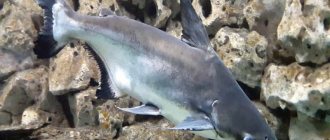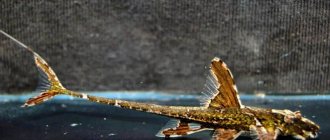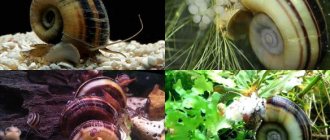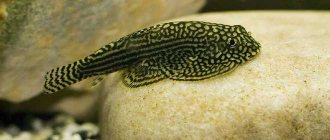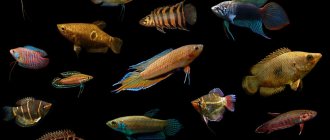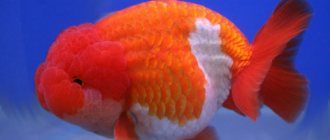A shark in an aquarium is a delightful and irresistible sight, a natural, mesmerizing beauty, with its entire appearance causing incredible delight. Seeing this, you will get an incredible amazing feeling and a lot of unforgettable impressions. An aquarium with such exotic fish will make your home more comfortable, and your guests will be in constant delight.
Siamese pangasius or shark catfish has been known for many hundreds of years, but you can see it at home relatively recently. The fish looks like a mini shark, but is peaceful in nature.
Description of the species
Pangasianodon hypophthalmus (lat.) - refers to a species of ray-finned fish of the Pangasiidae family, the order of catfishes. The first mentions are traced back to 1800. Natural habitat is freshwater. The largest populations are often found in the waters of the Mekong and Chao Phraya rivers, with smaller numbers in the rivers of Thailand, Southeast Asia, Laos, Cambodia, Vietnam and Tonle Sap Lake.
In nature, it reaches a length of 130 cm and a weight of 44 kg. Freshwater shark has been fished for many centuries; its fillets are used in the preparation of many exotic dishes and for sale for export. The size of some species can reach up to 2.5 m.
Sharks feel great in an aquarium if all favorable conditions are created. Externally they are very similar to a predatory shark. The skin on the body of an aquarium shark is thin and delicate, and does not have bony scales. The fins are dark gray or black. The dorsal fin has six branched rays shaped like a triangle. The caudal fin is two-lobed, with an elongated anal fin extending from it. The body color of a young shark is silver, but darkens over time; there are two oblong stripes along the lateral line, which disappear as the fish matures. The head is flattened, large eyes, two pairs of mustaches. Large mouth with sharp teeth, the lower part and peritoneum are silvery. The body size is from 15 cm to 50 cm in aquariums. Life expectancy is 10–15 years or longer.
The subtleties of keeping exotic sharks from professionals
Keeping aquarium predators is unproblematic and simple. You should approach the purchase of this fish responsibly and think through the following questions in detail:
- What type of mini sharks to buy for your home.
- What volume of aquarium is suitable for fish to keep them comfortable?
- What decorations, filters and compressors to choose.
Even a novice aquarist can create ideal living conditions by strictly following the order and relying on knowledge.
Aquarium: volume and shape
For proper maintenance, the volume of water for sharks requires at least 400 liters. Otherwise, the fish will not be able to fully move, and therefore develop. Round tanks or hexagon-shaped aquariums are ideal in shape. As decoration, place small pebbles or flat stones on the bottom.
A shark needs a large aquarium in which it can swim in a circle.
Water
Correctly selected water will be a comfortable habitat for sharks. Normally it should be around 28-30 C°. In a cool environment, fish catch colds and become seriously ill. It is preferable to prepare water of medium hardness. A neutral or slightly alkaline environment is ideal for a predator.
Feeding
The shark feeds on seafood. The diet should include shrimp, fresh or frozen squid and lean fish. Young individuals will happily eat ground fish products. For mature predators, it is enough to cut everything into small pieces.
The most popular types of aquarium sharks
Pangasianodon hypophthalmus differ not only in appearance from each other, but also in taste preferences, size, habits and character. The most common types of highly finned pangasius:
- Dwarf sharks are small, up to 25 cm. They are a viviparous species, produce offspring of up to 10 sharks, the size reaches up to 6 cm. Aquarists consider them the most popular among decorative aquarium sharks. They love warm water. They have sharp teeth. They love to eat cephalopods. The shark has luminescent organs that glow on the lower and lateral fins and the lower part of the abdomen. With good maintenance, life expectancy is up to 10 years.
- The pennant, freshwater river shark or shark catfish, is the fish that has the greatest external resemblance to the predator. In the natural environment it can reach up to 1.5 m, in domestic ones no more than 60 cm. It has interesting behavior, is very timid and when frightened pretends to be dead, but after 20–30 minutes everything returns to normal. It is not recommended to tease; when irritated, it hits the walls of the aquarium, which can cause damage to itself.
- The black shark is beautiful and graceful. Gluttonous, if it feels that it is not being fed enough, it periodically makes attempts to attack its neighbor in order to feast on it. If something is wrong in the kingdom, she immediately becomes lighter in color. Signaling the owner to find out the reasons why she doesn’t like it. The black bicolor shark is of fantastic beauty, with velvety black skin and a bright red tail. She has an aggressive and capricious character.
- The Colombian shark catfish or silver shark is a unique fish that has echolocation, this is a way of communicating with relatives in turbid water. The upper fins are poisonous, but the poison is not fatal.
Keeping an aquarium fish Shark Balu
Not recommended for beginner aquarists. This requires experience and a large aquarium. Fish is demanding in terms of maintenance.
The shark's habitat is rivulets and streams with a fairly fast flow, therefore, for an appropriate flow of water into the aquarium, it is advisable to install a strong aerator with a filter. Water is preferably of medium hardness or soft, with acidity slightly below zero, water temperature 24-25 degrees. The fish loves currents and natural light. Sometimes the Shark Ball jumps out of the water, so the aquarium must be covered with a lid. In the natural environment it grows up to 40 cm, in captivity it will grow less - up to 20 cm.
Omnivorous fish. Live, dry, plant food is suitable for food. Vegetables that are suitable include: nettle leaf, scalded lettuce, dandelion and spinach. Feeding should be varied and balanced. Bloodworms and cheese are not suitable for food - they can cause stomach upset. Dry food needs to be changed periodically. Such food must be purchased in packages in accordance with the date of manufacture. Store closed so that pathogenic flora does not develop in it. You also need fish food - in flakes, granules, frozen, freeze-dried, enriched with vitamins. The diet needs to be varied as much as possible.
Eats actively all day long. It takes food from the water column, but reluctantly from the bottom. While eating, they characteristically grab food with their gills and make gurgling sounds. A voracious fish can harm itself, so you need to regulate the amount of food, and sometimes arrange a fasting fasting day.
The aquarium should be decorated with pebbles, as well as small driftwood, since the fish prefers large spaces. It is allowed to add artificial or aquarium plants: Anubias, Vallisneria, add snails.
When purchasing a new inhabitant(s), you should not immediately add him/her to the rest of the fish in the aquarium. Create a quarantine. Monitor her health for a week or two. If the fish is healthy, you can release it into the main aquarium. You can also quarantine a sick fish and treat it separately from others, without exposing all the inhabitants of the sea house to medications. They may suffer from rubella, semolina, and aeromonosis.
Very often fish get sick due to poor water quality. Therefore, a weekly 30 percent water change is provided.
Do not frighten: knock, turn on bright lights, do not make sudden movements in the water.
Keeping in an aquarium
It is considered fashionable to keep freshwater sharks in aquariums today. When making such a decision, a number of mandatory requirements for keeping sharks must be met.
Sharks grow quickly and can reach more than 60 cm in some cases, but this depends on the conditions of detention. For a comfortable stay, the size of the aquarium should be with a top lid, with a volume of at least 350 liters, and be prepared to increase it in the future. There are also species that live exclusively in flocks and require a volume of 1200 liters or more.
To decorate the shark kingdom, place non-sharp large pebbles, beautiful driftwood, and all kinds of shelters. At the bottom there is sand or fine, non-sharp gravel, plants with a well-developed root system are planted around the side walls, or in clay pots. All sharp and prickly objects are excluded; the shark can injure the skin.
The optimal water temperature is 22 to 28 °C, water hardness is from 2 to 20, pH 6.5 to 8.0. Measure nitrate and ammonia levels. Change water up to 40% of the total volume every week. Aquarium sharks do not tolerate dirty water well, so it is necessary to install good filtration. Create a good flow using a pump. It should be borne in mind that pangasius shark catfish and other small aquarium fish do not get along together. Lighting should be moderate.
Feeding
The shark catfish is quite voracious; the aquarium species is not particularly picky about food; it eats everything it finds. For its vital functions it requires a lot of protein and carbohydrates, the shark is constantly on the move, this requires a lot of energy. Consumes food of plant and animal origin.
As pets get older, their teeth fall out and they become vegetarians. Feed 2-3 times a day, duration of administration is about 5 minutes.
The diet should be balanced and varied.
- Pangasius catfish is a lover of lean fish, shrimp, squid, insects, and worms.
- Feed with chopped or grated cucumbers, cabbage, zucchini, and potatoes.
- It’s also good to eat fruit in small pieces.
- Prefers various cereals.
- They love to eat specially raised live fish.
Secrets of keeping Pangasius from professionals
Pangasius is a demanding and somewhat capricious false shark, so it is not suitable as a first fish for beginners and young aquarists. Those who are a little familiar with exotic fish or are willing to invest money in proper care may want to take a closer look at this species.
Choosing an aquarium
Fish grow quickly and can reach their maximum size in a short time. Therefore, when buying an aquarium, choose the largest capacity and capacity possible.
Pangasius is a schooling fish and it is recommended to have a school of at least 2-3 fish. Otherwise, being alone can lead to severe stress, illness and slow decline!
For a small family of 3 catfish, an aquarium volume of more than 600 liters is desirable. Choose roomy and wide models so that the fish feel comfortable and can move freely through a long space.
Few people know that this type of fish is very prone to jumping. Be sure to take this feature into account before choosing an aquarium model. Choose models with lids or custom ones with durable glass.
Smooth pebbles are suitable for decoration. Pay attention also to pebbles and all types of low-growing plants. Be sure to leave free space in the aquarium for the safety of the catfish. Complex decorative elements can cause injury and bruise.
Aquarium location
Pangasius is very susceptible to stress and fright , so place the aquarium with fish in quiet places where there will be no sudden screams, claps, or other unexpected situations.
When frightened, the catfish loses its bearings and rushes chaotically around space, hitting corners and objects. In addition, a sensitive fish may even faint from fear.
Nutrition
Pangasius feeds not like an ordinary catfish, but while afloat. This large fish will not sink to the bottom to feed, and will definitely not eat up any leftover food. If you notice aggressive and nervous behavior, attacks on neighbors, this means that Pangasius is hungry. Perhaps he simply does not eat enough during feeding. Treat your freshwater friend to special food, fish, chopped squid or shrimp.
00:36
Feeding pangasius
02:43
➤ Harm to pangasius fish ➤
Keeping it clean
By consuming a lot of food and especially meat, fish pollute the water with excretions from waste products. Therefore, it is important to install modern filter and compressor systems in the aquarium. Pangasius will get sick and wither before our eyes from contaminated water. Weekly it is necessary to replace up to 40% of the water in the aquarium with fresh water.
Choice of neighbors
The choice of neighbors for shark catfish must be approached with all responsibility. Suitable for an aquarium with still small sharks:
- barbs,
- angelfish,
- guppy,
- goldfish.
As soon as mini sharks begin to mature and grow, they already regard their miniature neighbors as prey and a tasty lunch. As they grow older, add other large and energetic fish to the catfish. Excellent companions for adult Pangasius will be:
- citron cichlazomas,
- parrots,
- astronotuses,
- other types of Asian fish.
I strongly recommend not keeping pangasius with small and leisurely fish. The small fish will be swallowed or injured by the awkward movements of the large catfish.
Breeding
These fish do not reproduce in a home aquarium.
Shark catfish compatibility
Pangasianodon hypophthalmus are completely non-aggressive and are well compatible with other aquarium inhabitants of the same size. In their natural environment they live in large flocks. It is not recommended to keep it with smaller fish, because Pangasius shark considers small fish exclusively as food.
Shark catfish in an aquarium
Shark catfish has good compatibility with other fish; the following are suitable for it:
- Cichlids.
- Large and bream-like barbs.
- Kalamoikhty.
- Labeo.
- Proportional polypterus.
- Knife fish.
- Gourami and others.
It should be taken into account that sharks live in the middle column of water, so you should have a neighbor who lives in the lower part.
Domestic shark - decorative fish for the aquarium
You can make your aquarium interesting and unusual by populating it with beautiful plants and exotic fish. From the many varieties, it is worth choosing a decorative shark - it will definitely become a decoration for an artificial pond. The domestic shark is absolutely peaceful and gets along well with other aquarium inhabitants.
A similar shark can be kept in an aquarium
Breeding
It is almost impossible to distinguish young individuals by gender. The shark reaches sexual maturity at the age of four years, while the freshwater female is lighter in color and much more massive than the male. Breeding aquarium fish at home is problematic and almost impossible. In Asia, shark catfish farming is done in lakes or water containers.
In the natural environment, adult fish go to spawn from July to November, moving upstream, spawning in underwater thickets, laying up to 100 thousand eggs. The fry appear after 2–4 days, after which Pangasianodon hypophthalmus return to their usual environment.
Reproduction
You can also get offspring from aquarium sharks in an unnatural environment. In order for the female to begin laying eggs, a number of conditions are necessary for this:
- Foods containing silicon;
- Vitamin supplementation;
- Content of iodine ions in a water tank.
When keeping sharks, it is important to use vegetation to a minimum
Shark catfish diseases
The first causes of shark disease are due to poor care, improper feeding and non-compliance with water standards or the size of the aquarium. Before you begin treating fish, it is necessary to correctly diagnose the disease and identify the causes of its occurrence.
The most common diseases:
- Pangasius in an aquarium can often damage itself by hitting the walls or being damaged by decorative objects. Subsequently, ulcers may appear on the skin of the decorative shark; the wound must be treated with potassium permanganate or brilliant green.
- In case of poisoning, treatment will be fasting or a protein diet.
- Oxygen starvation. Pangasius aquarium is located at the surface of the water, the catfish often swallows air. Urgently increase aeration, reduce temperatures, increase flow rate using a filter.
- Fin rot. Fin rot is most often caused by bacteria or a bite from another fish.
- Dropsy or bloating. Improve nutrition and water quality.
- Ichthyophthiriasis or white spots - bad water.
- Fungal disease or fish mold is white growths that look like mold. Dirty water.
Real shark or Pangasius
Children and adults are very surprised when they learn from a pet store seller that a harmless sea monster is swimming peacefully in an aquarium, and its almost complete copy is a harmless catfish. Pangasius is a beautiful large fish, belongs to the shark catfish family. You can visually identify an aquarium shark from a real predator by its characteristic color and body shape. Young representatives have a bluish or ash color. Bright silvery stripes are clearly visible on the sides of catfishes. Despite the fact that the fish are almost identical, you can recognize a peace-loving catfish by the following characteristics:
- flattened head shape,
- outstanding eye shape and large mouth,
- four mustaches,
- fringe on the anal fin,
- The fin on the back is set upward.
The external differences between pangasius and a real shark are clearly visible in the photo.
The catfish has a certain similarity with a predator in its dynamic swimming style. In a flock they actively scour in search of food and love to swim in circles.
There are 3 types of fish most often found in artificial habitats:
- High-finned pangasius.
- Siamese pangasius.
- Small Pangasius.
An adult shark catfish reaches an average length of 60 cm.
Adviсe
Follow the standards for care and maintenance and you will be able to avoid many problems, and your Pangasianodon hypophthalmus will always be irresistible and attract your attention.
- The shark aquarium must be equipped with everything necessary.
- Don't hand feed.
- Wear gloves when cleaning.
- When adding a new individual to the aquarium, keep it separately for a while to make sure it is healthy.
- It is advisable to keep sick fish separately during the treatment period until complete recovery.
- Purchase a test kit to measure water quality.
- Clean the filter more often.
Remember that the responsibility for the life of this graceful fish, which directly depends on you.
How to feed mini sharks?
Mini-sharks remember feeding times - at the right time they begin to poke out of the water and fuss. However, there is a point that must be taken into account. The dwarf species does not know how to search for food at the bottom. The fish may simply not see the food and remain hungry. Therefore, you need to make sure that the fish eat. This species is omnivorous; you can feed sharks with food or small fish. If you bring shellfish, sharks will simply eat them, so it’s not worth the risk. If you don’t pay attention to how dwarf sharks feed, your pets may die from starvation.
What to do if there is always food left at the bottom? Just introduce bottom fish and you will solve the problem. Bottom fish will eat any debris that falls from above. A powerful filter will purify the water so that it is free of waste residues. There is no need to feed the fish by hand.
Selection of fish and aquarium
If you decide to get a miniature predator, you need to be especially serious about choosing a specific type of shark, as well as the aquarium in which it will spend its entire life.
Experts have made several recommendations:
- for a bottom-dwelling shark that can breathe while lying on the bottom, it is better to choose a square or rectangular aquarium with sharp corners;
- for pelagic fish, a ring tank or one with rounded corners is suitable so that the fish can calmly “turn in circles” without braking in front of obstacles;
- the volume of the aquarium depends on the number of individuals - there should be at least 40 liters per fish, in addition, it is necessary to take into account its intensive maturation when it increases in size;
- You should not populate different types of mini-sharks into one underwater house, since each has its own requirements for temperature, water salinity, the presence of vegetation, and each has a different way of life and movement.
Dwarf spiny shark
| Dwarf spiny shark | ||||||||||||||||||||||||||||||||||
| Scientific classification | ||||||||||||||||||||||||||||||||||
intermediate ranks Domain:
| ||||||||||||||||||||||||||||||||||
| International scientific name | ||||||||||||||||||||||||||||||||||
| Squaliolus laticaudus Smith & Radcliffe, 1912 | ||||||||||||||||||||||||||||||||||
| Synonyms | ||||||||||||||||||||||||||||||||||
| ||||||||||||||||||||||||||||||||||
| Area | ||||||||||||||||||||||||||||||||||
| Security status | ||||||||||||||||||||||||||||||||||
| Least Concern IUCN 3.1 Least Concern: 60214 | ||||||||||||||||||||||||||||||||||
| ||||||||||||||||||||||||||||||||||
The dwarf spiny shark, or dwarf deep-sea shark (lat. Squaliolus laticaudus) is a little-studied species of sharks of the genus of dwarf spiny sharks from the Dalatiidae family. The species is widespread in all oceans except the Arctic Ocean. It lives at depths from 200 to 1200 m. It makes daily vertical migrations. One of the smallest shark species. The maximum recorded size does not exceed 28 cm. These sharks have an elongated, spindle-shaped body with a large conical snout and rather large eyes. There is a spine at the base of the first dorsal fin. The belly is covered with bioluminescent photophores, masking the silhouette of the fish. The diet consists of small squid and bony fish. Reproduction probably occurs by ovoviviparity. The species is not of interest to commercial fishing.
Aquarium dwarf shark


